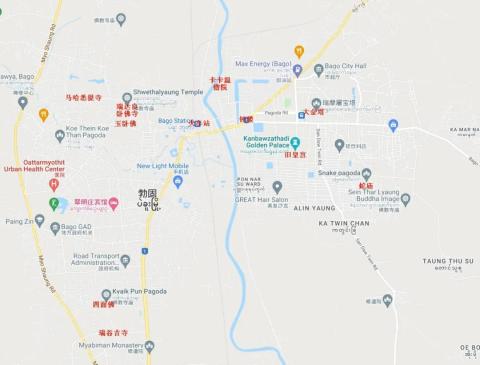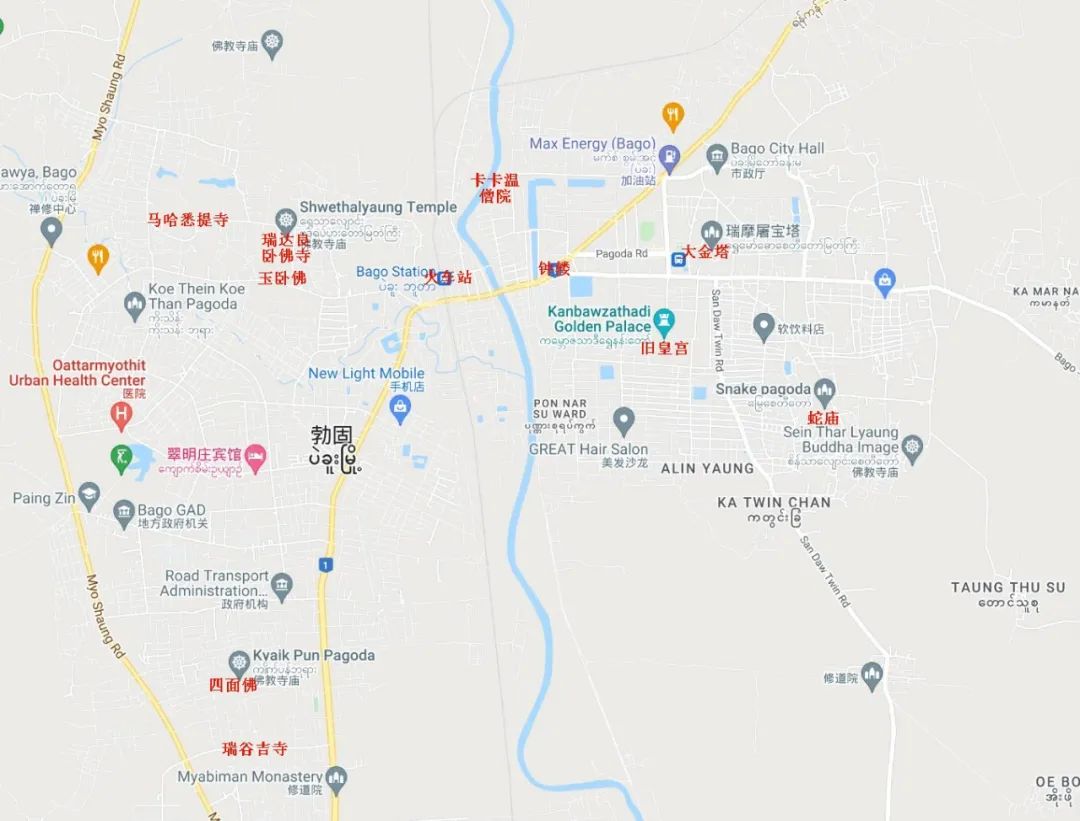
Bago is the capital of Bago Province, with a population of approximately 400,000, and is the fourth largest city in Myanmar. Bago City is located on the Yangon-Mandalay railway and highway line, on the Bago River, and is a transportation hub and industrial and commercial trade center.
In the more than 200 years since the fall of the Bagan dynasty, Myanmar has experienced a situation where the Mon, Bamar, Shan, and Rakhine ethnic groups each occupied one side. Before being destroyed by the Toungoo Burmese emperor Bayinnaung, Bago had been the capital of the Mon kingdom at that time. The Bago dynasty was a local Burmese separatist regime established after the collapse of the Bagan dynasty. Valiliu, the leader of the Mon tribe in Lower Myanmar, was established in 1281. The dynasty moved its capital to Bago in 1369. The Bago Kingdom was under the rule of Queen Xinxiufu (1453-1472) and her son-in-law Bodhidharma Siddhi (1472-1492). reached its peak. Bago was the center of Buddhism in Myanmar from the 14th to the 16th century. The precepts observed by the Myanmar monks were re-introduced from Ceylon (now Sri Lanka) and passed down to this day. Later, Mang Yinglong unified Myanmar and set the capital in Bago.
Distribution map of Bago’s main attractions

There are many Buddhist temples in the city of Bago. Visiting Buddhist temples and palaces has become a tourist theme. After arriving in Bago, I found a hotel that provided bicycles and started my journey by bike. First, I came to the Erawan Buddha Temple.

Kyaik Pun Pagoda has four 27-meter-high back-to-back Buddha statues facing in all directions. They depict Buddhas wearing different cassocks and decorations. The Buddha statues seem to be very new, but they are actually products of the Bodhidharma Siddhi era in the 15th century. They are known as Freshly painted results.





Riding south, we soon came to Rui Guji Temple.

Shwe Gugyi Pagoda is a temple presided over by Bodhidharma Siddhi and modeled after the Bodh Gaya Temple in India. There were originally monuments around the temple telling important stories that happened every seven days after the Buddha's enlightenment. Now they have completely disappeared, leaving only The ruins of the temple are breathtaking. Nowadays, there are many new buildings donated by believers around the Stupa, including two mini stupas modeled after the Bodhgaya Temple.




There is also the “scene” of giving


Continuing to ride northwest, there are temples everywhere along the way.

Mahazedi Pagoda was built in 1560 by Emperor Mang Yinglong of the Toungoo Dynasty. He personally brought back the Tooth Relic of Buddha from Sri Lanka and placed it in the Mahasiddhi Temple. Unfortunately, this "Buddha's Tooth" was later proven to be a fake.


The tops of the stairs leading to the golden pagoda are decorated with small pagodas. The temple is decorated with uniform wavy golden roofs from multiple angles, which complements the white walls and is very beautiful.











Small temple next to the golden pagoda

Shwethalyaung Buddha is an "indoor" reclining Buddha. It was built in 994, with a total length of 55 meters and a height of 16 meters. Due to the war in 1757, the Buddha statue was buried deep under the lush woods until 1881. It came to light when the colonial government planned to build a railway in Bago. It was renovated and roofed in 1948. Now the Buddha statue is equipped with "pillows" of colored glaze and precious stones.


Not far south of Wat Pho in Shwedaliang is Fish Lake.


There is also a reclining Buddha by the lake, called Mya tha Lyaung Buddha. This is an open-air reclining Buddha, 55 meters long and 16 meters high. It was built in 2002.



Stay in Bago for the night.
Get up early and look at the street scene. This is the clock tower.

The water surface in the city, next to the temple

I rode my bicycle to the Snake Pagoda. It is said that a 9-meter-long snake is enshrined here. It was the reincarnation of a monk named Hsipaw. It is said to be 130 years old. But I didn't see it. All I could see was the snake's body. Various sculptures are wrapped around pillars, lying beside escalators, and include snake heads and other styles.





Buddhists in Myanmar believe that worshiping sacred snakes can help them realize their wishes, and they even donate snakes to temples to accumulate merit. These snakes can crawl freely in temples without restraint, and are regarded as sacred snakes by many people. This worship of snakes comes from the story of the snake king protecting Sakyamuni from the wind and rain.
Next I came to the old royal palace, Kanbawzathadi Palace.


The Old Palace, also known as the Golden Palace, is located in a large courtyard. The main building is a luxurious palace built by King Mangying Long in 1556. The palace is built of teak and is plated with gold to show the abundance and national power of the Taungoo dynasty's treasury. Due to its prosperity, the palace was burned down in 1599. The palace you see now is a replica that was rebuilt in 1992. The real antiques here are teak pillars, which are unearthed cultural relics during archaeology, with a total of 167 pillars.


Inside the palace









There is also a Queen's Palace here, which is smaller in scale.





Opposite the Royal Palace is the Shwedagon Pagoda

Shwemawdaw Paya is the most famous temple in Bago. It was built more than 1,000 years ago. The Shwemawdaw Pagoda in the middle is 112 meters high, which is 14 meters higher than the Shwemawdaw Pagoda in Yangon. It is the oldest temple in Myanmar. The tallest tower is also a landmark building in Bago. In the past 600 years, the Shwedagon Pagoda has experienced many earthquakes and has been continuously renovated. Today, the surface of the Shwedagon Pagoda is gold-plated, and there are 121 smaller golden pagodas around it. Especially when the lights are turned on at night, you can clearly see it even if it is more than ten kilometers away from the city.




Tharthana Bademhan Temple at the entrance of Shwedagon Pagoda

Finally I came to Kya Khat Wine Monastery.


Kakawin Monastery is one of the three largest Buddhist monasteries in Myanmar, with thousands of monks living in it. The most famous scene here is the monks’ meal held at 10:30 every morning. At that time, the monks will line up and slowly walk to the eating place in an orderly manner with their bowls in hand to receive alms from believers. The local believers will prepare rice, vegetables, and biscuits. , snacks, drinks and even stationery were carefully placed into the monk's alms bowl. There was no verbal communication during the entire process, and the scene was solemn and sacred.


After receiving the alms, the monks will enter the restaurant in an orderly manner, chant sutras first, and then eat slowly. In addition to the food donated, there are special cooks here to cook dishes and soup for them. In addition to rice, the meals also include meat and Fruit seems to be treated well.





The cook cooks


Serve soup

In this way, I ended my two-day trip to Bago, continued to ride back to Yangon, and transferred to Zijar Village in the southeast corner of Myanmar.
Trip map (350 kilometers)

